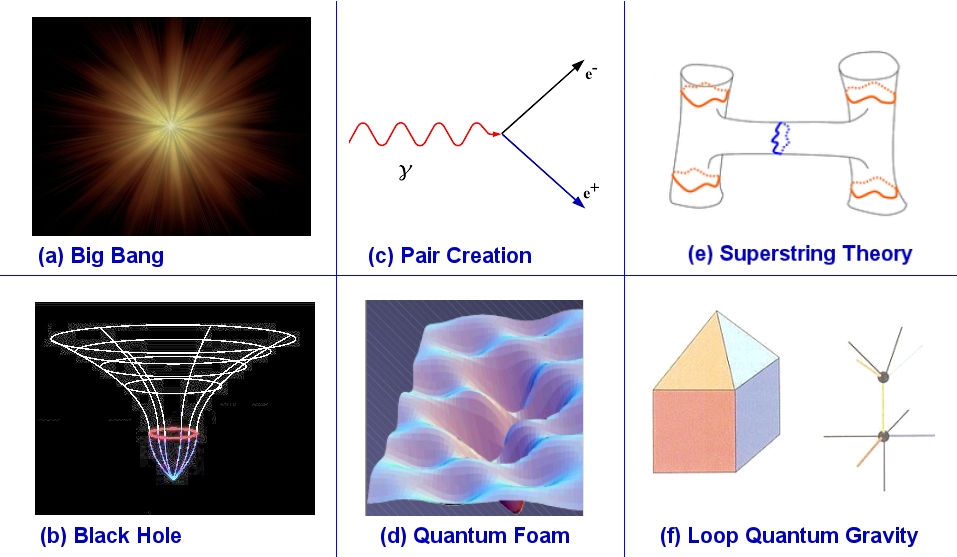
| Home Page | Overview | Site Map | Index | Appendix | Illustration | Preface | Contact | Update | FAQ |
 |
Soon after Max Planck introduced the Planck constant h in 1899 to account for the spectrum of blackbody radiation, he realized that the only way to construct a unit of length out of h = 6.625x10-27 erg-sec, the velocity of light c = 3x1010 cm/sec, and the gravitational constant G = 6.67x10-8 cm3/sec2-gm, is LPL = (Gh/c3)1/2. This is the now famous Planck length. Since h is related to Quantum Theory, c and G emerge from the Special and General Relativity respectively, it implies that any length scale in a Quantum Gravity Theory would involve LPL, which is extremely short at 4x10-33 cm. |
 |
|
Figure 15-32 Realm of Planck Scale [view large image] |
|
 = h/mc, which is related to Compton scattering. It appears also in quantum field equations to define the length scale of the quantum process. In the present context, it can be interpreted as the appearance of
= h/mc, which is related to Compton scattering. It appears also in quantum field equations to define the length scale of the quantum process. In the present context, it can be interpreted as the appearance of
 |
pair-creation with large quantum fluctuation in momentum (~ mc) resulting in position uncertainty ( x x  / / p) about the order of a Compton wavelength. Individual object does not exist in region below that line as the single particle description is no longer applicable. The straight line on the right is a plot of mass against the Schwarzschild radius rs=2Gm/c2. Objects cannot be accessed in region below that line as it would be wrapped inside the event horizon (since r < rs). All objects exist only within the region bound by these two lines. Table 15-03 lists some of the objects within or at the border. The two lines converge at a point where both quantum effect and gravity become important. p) about the order of a Compton wavelength. Individual object does not exist in region below that line as the single particle description is no longer applicable. The straight line on the right is a plot of mass against the Schwarzschild radius rs=2Gm/c2. Objects cannot be accessed in region below that line as it would be wrapped inside the event horizon (since r < rs). All objects exist only within the region bound by these two lines. Table 15-03 lists some of the objects within or at the border. The two lines converge at a point where both quantum effect and gravity become important.
|
Figure 15-33 Quantum Gravity Convergence |
Figure 15-33 also shows some characteristic scales of the universe. |
| Object | Mass (gm) | Compton Wavelength (cm) | Size (cm) |
|---|---|---|---|
| Electron | 9.1x10-28 | 3.8x10-11 | ~ 10-16, Pair Creation at High Energy |
| Proton | 1.67x10-24 | 2x10-14 | ~ 10-13, Composite Particle |
| Higgs Boson | 1.25x10-22 | 10-16 | Excitation from Higgs Field, Unstable |
| Buckyball (C60) | 1.2x10-21 | 2.8x10-17 | ~ 10-7 |
| Protein | ~ 10-19 | 3.2x10-19 | ~ 10-6 |
| Virus | ~ 10-8 | 3.5x10-30 | ~ 10-5 |
| Object | Mass (gm) | Schwarzschild Radius (cm) | Size (cm) |
| Earth | 6x1027 | 0.9 | 6x108 |
| Sun | 2x1033 | 4x104 | 2x1011 |
| Neutron Star | 1034 | 2x105 | 106 |
| Cygnus X-1 | 2x1034 | 4x105 | Stellar Binary + Black Hole |
| Sgr A* | 8x1040 | 1.2x1013 | ~ 6.4x1012 Milky Way Black Hole |
| 3C273 | 4x1042 | 6x1014 | Quasar + Black Hole |
| Observable Universe | 4x1055 | 6x1027 | 1028 (very close to form a Black Hole) |
 t
t  E
E 
 giving EPL =
giving EPL =  /tPL.
/tPL. G2m3/(
G2m3/( c4).
c4). |
Another example : The direction of cosmic evolution of entropy always tends to increase or at least to remain constant as shown in Figure 15-35. According to the scenario of backward tracing, the universe would be a dense pack of particles with maximum entropy at the beginning. It is not clear then what makes this trend of increasing entropy if it was at its maximum already. It turns out that there would not be any problem to explain the origin of low entropy at Big Bang if it starts from a black hole (see "Origin of Time"). It increases upward forever since then as expected by the 2nd law of thermodynamics. |
Figure 15-36 |
Figure 15-36 shows the relationship between quantum gravity and the other branches of physics at the limit of the various universal constants. In other word, the various theories at the perimeter are just the special cases of the more general theory of quantum gravity - hence it is often referred to as the Theory of Everything. |




 Black Hole evaporation ________________________________________
Black Hole evaporation ________________________________________ -CDM model):
-CDM model): ): Cosmological constant = dark energy, responsible for accelerating expansion.
): Cosmological constant = dark energy, responsible for accelerating expansion. ________________________________________
________________________________________